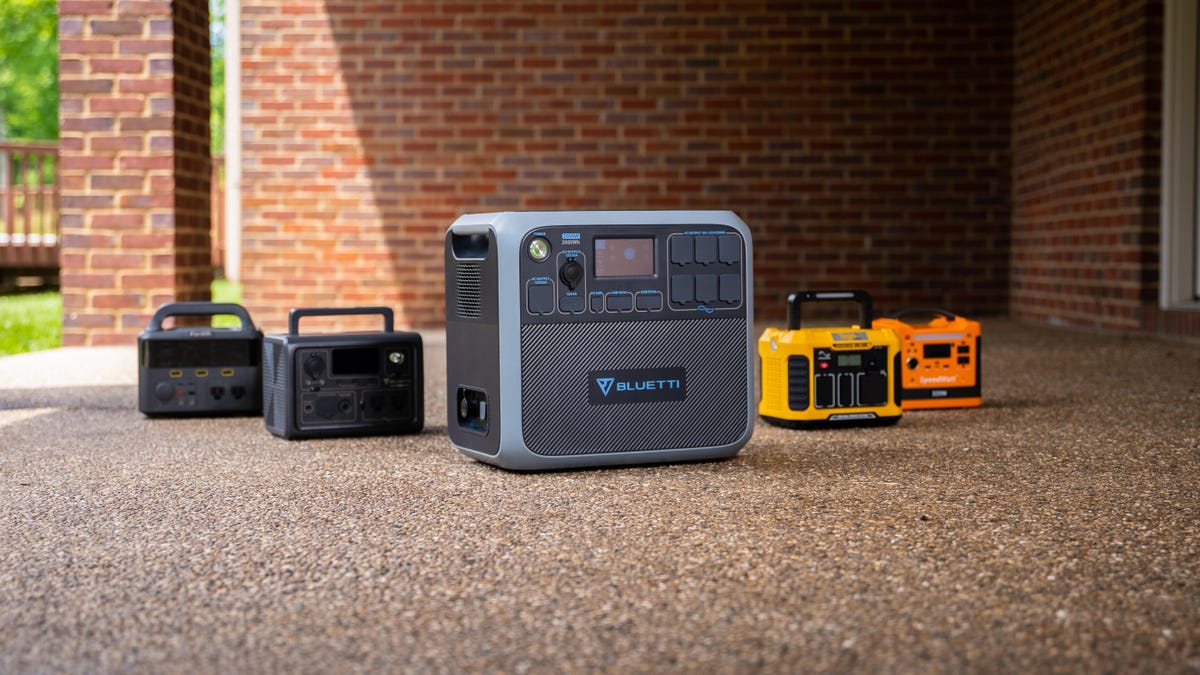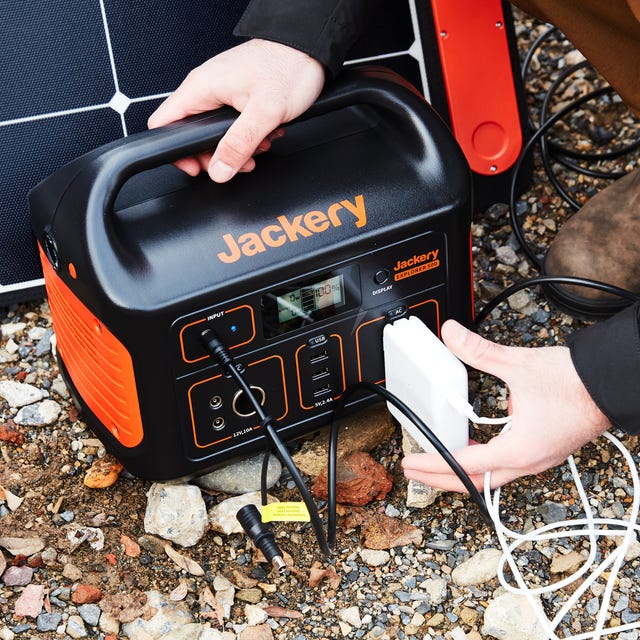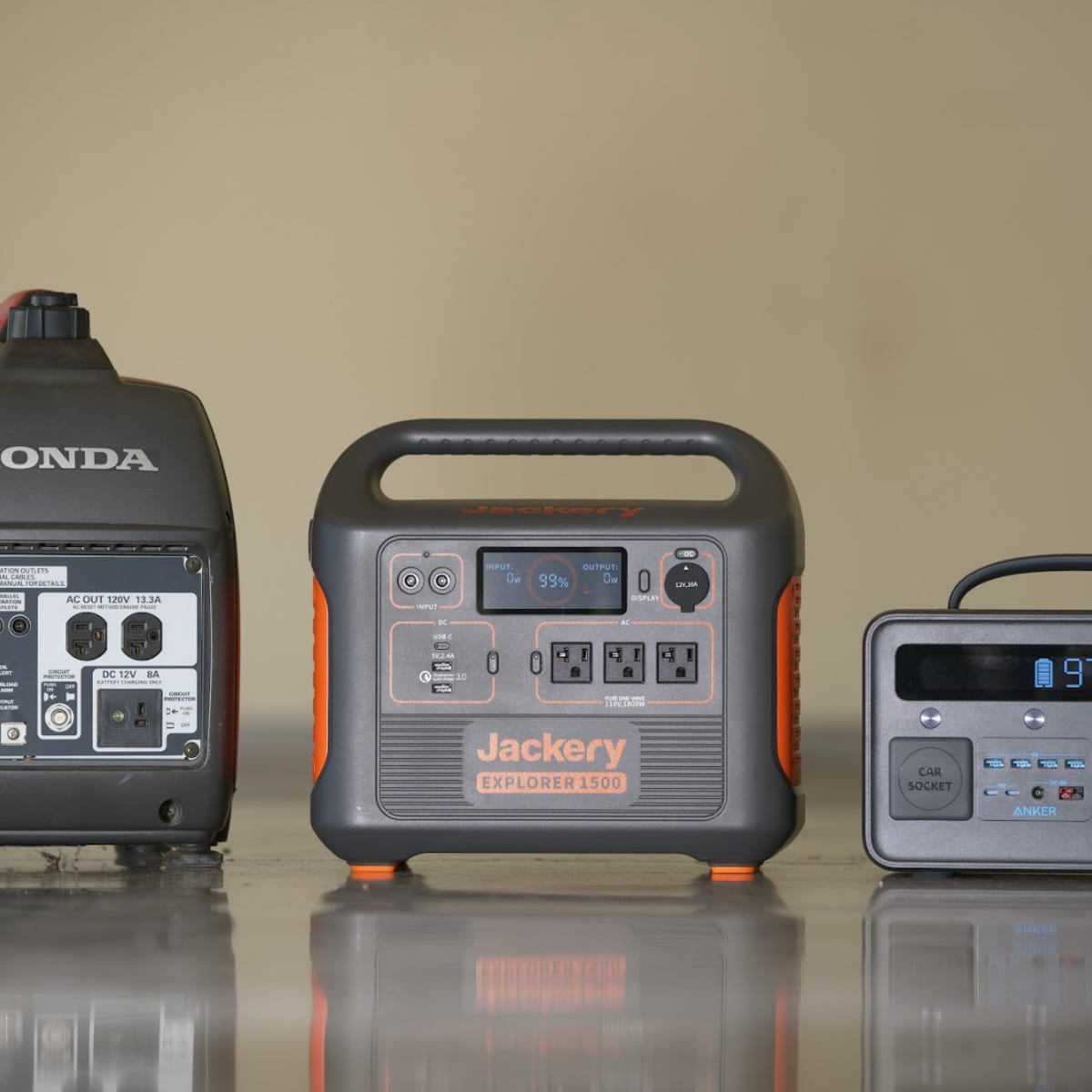Yes, you can charge a portable power station with a generator. Portable power stations are designed to be charged by various sources, including generators, solar panels, and wall outlets.

When using a generator, make sure to follow the manufacturer’s instructions for the specific power station model to ensure safe and efficient charging. As our reliance on electronic devices grows, so does the demand for reliable portable power solutions. Portable power stations have become increasingly popular due to their ability to provide on-the-go power for various devices such as smartphones, laptops, and even small appliances.
When it comes to charging these power stations, many people wonder if they can utilize a generator for this purpose. We will explore the compatibility of portable power stations with generators and provide insights into how this can be accomplished effectively. Whether you’re an outdoor enthusiast, camper, or someone who simply wants a reliable backup power source, understanding how to charge a portable power station with a generator can be invaluable.

Credit: www.cnet.com
How Does A Generator Work?
How Does a Generator Work?
A generator is a device that converts mechanical energy into electrical energy. It operates on the principle of electromagnetic induction, discovered by Michael Faraday in the early 19th century. Here’s how a generator works:
-
Mechanical Energy Input: The generator requires a source of mechanical energy to operate. This energy can come from various sources such as a steam turbine, water turbine, wind turbine, or internal combustion engine. The mechanical energy causes the generator’s rotor or shaft to rotate.
-
Electromagnetic Induction: As the rotor rotates within the generator, it passes through a magnetic field created by stationary magnets or electromagnets. This interaction between the rotating magnetic field and the stationary magnetic field induces an electric current in the wires of the rotor due to electromagnetic induction.
-
Generation of Alternating Current (AC): The electric current produced in the rotor is alternating in nature, meaning it periodically changes direction. This alternating current is often referred to as AC electricity. The frequency (rate of change of direction) of the AC current is determined by the speed of rotation of the rotor and the number of poles in the generator.
-
Output Connections: The alternating current generated in the rotor is then transferred to the generator’s output terminals through slip rings or a commutator. These output terminals are connected to electrical conductors that transmit the electricity to the external load or electrical system.
-
Voltage Regulation: The voltage of the generated electricity depends on factors such as the strength of the magnetic field, the speed of rotation of the rotor, and the number of turns in the generator’s windings. Voltage regulation mechanisms, such as voltage regulators or automatic voltage regulators (AVRs), are often employed to maintain a steady voltage output despite fluctuations in the load or speed of the generator.
-
Conversion to Direct Current (DC): Some generators produce direct current (DC) electricity instead of alternating current. In such generators, the AC output is converted to DC using a device called a rectifier. DC generators are commonly used in applications such as battery charging and automotive alternators.
The functioning of a generator is an essential aspect to understand when it comes to charging a portable power station. Generators work by converting mechanical energy into electrical energy. They do this through a process called electromagnetic induction, which involves the interaction between conductors and magnetic fields.
Understanding The Basics
A generator consists of two main components: a rotor and a stator. The rotor is the moving part of the generator, usually composed of a coil of wire wrapped around an iron core. The stator, on the other hand, is the stationary outer part of the generator comprising another set of coils.
When a generator is operating, the rotor is spun by an external power source, such as an engine or turbine. As the rotor turns, it creates a rotating magnetic field around the coil. This rotating magnetic field then induces voltage in the stator coils, leading to the production of electrical energy.
Types Of Generators
Generators come in different types, each with its unique characteristics and applications. Here are some common types you may encounter:
| Type of Generator | Description |
|---|---|
| Diesel Generator | Uses diesel fuel for combustion and is often more fuel-efficient and durable. |
| Gasoline Generator | Runs on gasoline and is generally more affordable but less efficient than diesel generators. |
| Propane Generator | Powered by propane gas, offering a cleaner fuel option with longer shelf life compared to gasoline or diesel. |
| Inverter Generator | Provides a more stable and consistent power output, making it suitable for sensitive electronics. |
These are just a few examples of generator types, each catering to specific needs and circumstances. Understanding the type of generator you have or plan to use can help determine its compatibility with charging a portable power station.
Overall, comprehending how generators work is fundamental in grasping their ability to charge a portable power station. Whether you have a diesel, gasoline, propane, or inverter generator, the concept of electromagnetic induction lies at the core of their functionality.
What Is A Portable Power Station?
What is a portable power station?
A portable power station, also known as a portable power generator or battery generator, is a compact and versatile device designed to provide on-the-go power for various electronic devices and appliances. Unlike traditional generators that rely on fuel combustion to generate electricity, portable power stations use rechargeable batteries to store electrical energy, which can then be used to power or charge devices when needed.
Portable power stations typically consist of the following components:
-
Battery: The heart of the portable power station is its rechargeable battery, which stores electrical energy. These batteries are often lithium-ion or lithium-polymer, known for their high energy density and lightweight characteristics.
-
Input Ports: Portable power stations feature input ports for recharging the battery. These input ports may include AC wall outlets, DC car adapters, solar panel connectors, or even wind turbine inputs, providing versatility in recharging options.
-
Output Ports: Output ports allow users to connect and power or charge various devices and appliances. Common output ports include AC outlets, DC ports (such as cigarette lighter sockets), USB ports, and sometimes even wireless charging pads for compatible devices.
-
Inverter: Many portable power stations include an inverter, which converts the stored DC (direct current) electricity from the battery into AC (alternating current) electricity, mimicking the power grid’s electricity. This allows the power station to power devices that require AC power.
-
Control Panel: The control panel typically features indicators, buttons, or a display screen to provide information about the power station’s status, such as battery level, input/output power, and charging status.
-
Housing: The housing of a portable power station is typically made of durable materials such as plastic, aluminum, or metal alloys. It is designed to protect the internal components from damage and provide portability for on-the-go use.
Portable power stations come in various sizes, capacities, and configurations to suit different needs and applications. They are commonly used for camping, outdoor activities, emergencies, remote work, and powering electronic devices and appliances in areas without access to traditional power sources.
Exploring The Features
Portable power stations are equipped with a range of features that make them valuable for various scenarios. These features often include multiple output options, such as AC, DC, and USB ports, as well as a rechargeable battery or the ability to be charged via solar panels. In addition, many portable power stations also feature built-in surge protection, LED indicators for battery status, and lightweight, portable designs, making them ideal for use during camping, outdoor events, and power outages.
Benefits Of Using A Portable Power Station
- Convenient power source for outdoor activities and events
- Emergency backup power during power outages
- Ability to charge electronic devices on the go
- Versatile power options for running appliances and tools
- Portability and ease of use in off-grid settings
Can A Portable Power Station Be Charged With A Generator?

Yes, a portable power station can typically be charged with a generator. Many portable power stations are designed to accept various input sources for recharging their internal batteries, and a generator is one of the compatible options. Here’s how it works:
-
Generator Output Compatibility: Generators typically provide AC (alternating current) power through outlets similar to those found in homes. Portable power stations often come with an AC input port that allows them to be charged using this type of power source.
-
Connection: To charge a portable power station with a generator, you would use a standard power cord with the appropriate plug for the generator’s outlet on one end and the AC input port on the power station on the other end. Simply plug one end of the cord into the generator’s outlet and the other end into the AC input port on the power station.
-
Charging Process: Once the power cord is connected, start the generator to supply power to the portable power station. The generator will provide AC electricity, which the power station’s internal components will convert and store in its battery.
-
Monitoring: During the charging process, you can monitor the power station’s status using its display screen or indicators to track the battery level and charging progress.
-
Safety Precautions: As with any electrical device, it’s essential to follow safety precautions when charging a portable power station with a generator. Ensure that the generator is operated in a well-ventilated area to prevent carbon monoxide buildup, and follow all manufacturer instructions and safety guidelines for both the generator and the power station
Portable power stations have become increasingly popular for outdoor activities, emergencies, and off-grid living. However, there may be instances where your power station runs low, and you wonder if you can charge it with a generator. Let’s explore this question in detail.
Compatibility Between Generators And Power Stations
Before attempting to charge your portable power station with a generator, it’s essential to determine if the two are compatible. Most modern portable power stations can indeed be charged using a generator, but there are a few factors to consider.
Factors To Consider
- Power Output: First, ensure that your generator’s power output is suitable for the power station. Check the power station’s input requirements and compare them to your generator’s output capabilities.
- Compatibility: Some power stations may not support charging from all types of generators. It’s important to verify compatibility with the manufacturer or in the product manual.
- Connection Method: Different power stations may require specific connectors or adapters to charge from a generator. Ensure you have the necessary equipment for a successful connection.
- Charge Controller: Confirm if the power station is equipped with a charge controller to regulate the incoming power from the generator, preventing overcharging and potential damage.

Credit: www.popularmechanics.com
Steps To Charge A Power Station With A Generator
Charging a power station with a generator is a straightforward process. Here are the steps to follow:
-
Prepare the Generator: Make sure the generator is set up and ready for operation. This includes ensuring it has sufficient fuel or is connected to a power source, as well as checking that it is in good working condition.
-
Position the Power Station: Place the power station near the generator in a well-ventilated area. Ensure there is enough space around both the generator and the power station to prevent overheating and to allow for safe operation.
-
Select the Charging Cable: Choose the appropriate charging cable to connect the generator to the power station. Most generators provide AC power through standard outlets, so you’ll typically need a power cord with a plug compatible with the generator’s outlet on one end and a connector compatible with the power station’s input port on the other end.
-
Connect the Charging Cable: Plug one end of the charging cable into the generator’s outlet, ensuring a secure connection. Then, plug the other end of the cable into the power station’s input port. Make sure the connections are tight to prevent any accidental disconnection during charging.
-
Start the Generator: Start the generator according to the manufacturer’s instructions. This may involve pulling a starter cord, pushing a button, or using an electric start mechanism, depending on the type of generator you have. Once started, the generator will begin supplying power through the connected charging cable.
-
Monitor the Charging Process: Keep an eye on the power station’s display screen or indicators to monitor the charging progress. You should see the battery level increasing as the power station receives power from the generator.
-
Safety Precautions: While the power station is charging, observe all safety precautions associated with generator operation. This includes keeping the area well-ventilated to prevent carbon monoxide buildup, avoiding overloading the generator, and following all safety guidelines provided by the generator manufacturer.
-
Complete Charging: Allow the power station to charge until the battery is fully replenished. The time it takes to fully charge will depend on factors such as the capacity of the power station’s battery and the output of the generator. Once fully charged, disconnect the charging cable from both the generator and the power station.
Charging a portable power station using a generator can provide a reliable source of backup power, especially in situations where solar or grid power sources are not available. To successfully charge your power station with a generator, you need to follow a few simple steps. This article will guide you through the process, ensuring a smooth and efficient charging experience.
Selecting The Right Generator
Before you start, it is crucial to select the right generator that is compatible with your portable power station. Consider the following factors:
- Power Output: Ensure the generator can generate enough power to meet the charging requirements of your power station. Refer to the manufacturer’s specifications for the recommended power output.
- Fuel Type: Determine whether you prefer a gasoline, propane, or diesel-powered generator, based on availability and convenience.
- Noise Level: If noise is a concern, opt for a generator with a lower decibel rating to minimize disruptions.
Connecting The Generator To The Power Station
Once you have selected the right generator, you need to connect it to your power station following these steps:
- Locate the AC output port on your generator. This is where you will connect the power station.
- Identify the AC input port on your power station. It is usually labeled as “AC Input” or something similar.
- Using an appropriate power cord, connect the AC output port of the generator to the AC input port of the power station. Ensure a secure connection.
- Switch on the generator and power up the power station. Verify that the charging process has started by checking the indicator lights on the power station.
- Leave the power station connected to the generator until it reaches a full charge. The time required may vary depending on the capacity and current charge level of the power station.
- Once the power station is fully charged, disconnect the generator by reversing the steps above. Ensure a safe disconnection to avoid any electrical hazards.
By following these simple steps, you can successfully charge your portable power station using a generator, ensuring a reliable and convenient backup power solution. Remember to always refer to the manufacturer’s instructions for your specific power station and generator to guarantee proper usage and prevent any potential damage.
Safety Precautions
Portable power stations can be charged with a generator, ensuring a constant power supply during emergencies or outdoor activities. Stay prepared and follow proper safety precautions when connecting the two to avoid any hazards.
When charging a portable power station with a generator, it’s essential to observe safety precautions to prevent accidents and ensure safe operation. Here are some safety tips to keep in mind:
- Ventilation: Always operate the generator and charge the power station in a well-ventilated area. Generators emit exhaust gases, including carbon monoxide, which can be harmful if inhaled in enclosed spaces. Avoid operating the generator indoors or in areas with poor ventilation, and never place it near open windows, doors, or vents where exhaust fumes can enter.
- Carbon Monoxide Detection: Install carbon monoxide detectors in the vicinity of the generator and power station charging area to alert you to the presence of harmful gases. Test the detectors regularly and replace batteries as needed to ensure they are functioning properly.
- Distance: Position the generator and power station at a safe distance from occupied spaces, including homes, tents, and recreational vehicles. Follow manufacturer recommendations regarding the minimum safe distance for generator operation to prevent exposure to noise and exhaust emissions.
- Stability: Ensure that the generator and power station are placed on stable and level ground to prevent tipping or falling during operation. Use appropriate supports or stabilizers if necessary to secure the equipment in place, especially in windy or uneven terrain.
- Fuel Handling: Handle fuel for the generator with care and follow proper refueling procedures to avoid spills and leaks. Use approved containers for storing and transporting fuel, and never refuel the generator while it is running or hot. Allow the generator to cool down before refueling to reduce the risk of fire.
- Electrical Safety: Use insulated and properly rated extension cords and charging cables when connecting the generator to the power station. Ensure that the cables are in good condition, without any fraying or damage to the insulation. Avoid overloading the generator by connecting too many devices or appliances at once.
- Fire Prevention: Keep flammable materials, such as gasoline, propane, and combustible debris, away from the generator and charging area. Regularly inspect the generator and power station for signs of overheating or electrical malfunctions that could pose a fire hazard. Have a fire extinguisher nearby and know how to use it in case of emergency.
- Manufacturer Guidelines: Follow all safety guidelines and instructions provided by the generator and power station manufacturers. Familiarize yourself with the equipment’s operation manual and safety precautions before use, and consult with the manufacturer or a qualified professional if you have any questions or concerns.
Importance Of Following Safety Guidelines
Portable power stations are a convenient and reliable source of energy, especially when you’re off the grid. However, when it comes to charging them with a generator, it’s crucial to understand and adhere to the necessary safety precautions. Following these guidelines ensures the safety of both yourself and the equipment involved.
Preventing Damage Or Accidents
Charging a portable power station with a generator can yield great results, but it’s important to prevent any potential damage or accidents along the way. By taking a few simple precautions, you can keep both your power station and generator in optimal condition.
– Place the generator on a level surface: Ensure the generator is positioned on a flat and stable surface to prevent any accidental tipping or movement during operation.
– Keep a safe distance: Maintain a safe distance between the generator and other objects to avoid any potential damage caused by heat, sparks, or exhaust.
– Utilize proper ventilation: Make sure the generator has enough space for proper ventilation to avoid overheating.
– Protect against the elements: Shield the generator and power station from rain, snow, or extreme weather conditions to prevent damage and electrical hazards.
– Use appropriate cables and connections: Ensure you use the correct cables and connectors when connecting the power station to the generator. This helps prevent electrical accidents and ensures a secure and efficient connection.
– Monitor fuel levels: Regularly check the fuel levels of the generator to prevent unexpected shutdowns during the charging process.
– Operate in a well-ventilated area: When using a generator, make sure it’s placed in a well-ventilated area to minimize the risk of carbon monoxide poisoning. Avoid running the generator indoors or in enclosed spaces.
By following these safety precautions, you can confidently charge your portable power station with a generator without any worries of damage or accidents. Remember, safety should always be a priority when dealing with electricity and any related equipment. Stay informed and ensure a smooth and risk-free charging experience.

Credit: www.cnet.com
Frequently Asked Questions Of Can You Charge A Portable Power Station With A Generator
Can You Charge A Portable Power Station With A Generator?
Yes, a portable power station can be charged with a generator, providing a reliable backup power source.
How Do I Charge A Portable Power Station With A Generator?
To charge a portable power station with a generator, simply connect the generator’s output to the power station’s input using the appropriate cables.
What Type Of Generator Is Suitable For Charging A Portable Power Station?
Any generator that can produce the required power output and has compatible connectors can be used to charge a portable power station.
Conclusion
To conclude, charging a portable power station with a generator is not only possible but also a practical solution for outdoor enthusiasts and those who rely on portable power. By following the manufacturer’s guidelines and ensuring compatibility between the power station and generator, you can enjoy a reliable and sustainable power source wherever you go.
With this flexibility, you can confidently embark on your adventures knowing that your portable power station will keep you connected and powered up.